Remote Healing: Telehealth’s Impact on American Healthcare
Telehealth has emerged as a transformative force in the United States, revolutionizing the way healthcare services are delivered and accessed. This innovative approach to medical care has witnessed a significant surge, especially in recent times.
A New Era of Accessibility
Telehealth in the USA has ushered in a new era of healthcare accessibility. With the use of digital technologies, individuals can connect with healthcare professionals from the comfort of their homes. This has proven invaluable for those living in remote areas, reducing barriers to entry and ensuring that medical expertise is within reach for a broader population.
Virtual Consultations for Efficient Care
One of the primary facets of telehealth is virtual consultations, allowing patients to meet with healthcare providers through video calls or online platforms. This not only enhances convenience for patients but also streamlines the healthcare process, minimizing the need for physical visits. Whether for routine check-ups or specialist consultations, virtual appointments have become a cornerstone of modern healthcare delivery.
Remote Monitoring and Chronic Disease Management
Telehealth plays a pivotal role in remote monitoring, particularly for individuals managing chronic diseases. Wearable devices and digital health tools enable patients to track vital signs and share real-time data with their healthcare providers. This proactive approach enhances disease management, reduces hospital readmissions, and empowers patients to actively participate in their own care.
Telepsychiatry: Addressing Mental Health Needs
The impact of telehealth extends beyond physical health to encompass mental well-being. Telepsychiatry has emerged as a vital component, providing individuals with remote access to mental health professionals. This is especially significant given the growing awareness of mental health issues, and telehealth offers a discreet and accessible avenue for seeking support and counseling.
Prescription Management and Medication Adherence
Telehealth platforms facilitate prescription management and medication adherence. Healthcare providers can electronically send prescriptions to pharmacies, and patients can conveniently pick up their medications. Additionally, digital reminders and alerts help individuals stay on track with their medication regimens, improving overall health outcomes.
Telehealth and Emergency Care
In emergency situations, telehealth provides a rapid response and initial assessment, guiding individuals on the appropriate course of action. From determining the severity of symptoms to offering immediate advice, telehealth has proven crucial in emergency care scenarios, potentially saving lives by expediting the provision of medical guidance.
Challenges and Regulatory Considerations
While telehealth brings numerous benefits, it also faces challenges and regulatory considerations. Issues such as reimbursement policies, licensure across state lines, and ensuring the security of patient data are areas that require ongoing attention. The evolving landscape necessitates a delicate balance between fostering innovation and maintaining robust healthcare standards.
Technological Advancements and Future Prospects
The landscape of telehealth continues to evolve with rapid technological advancements. From AI-driven diagnostics to virtual reality-enhanced therapies, the future holds exciting possibilities for expanding the scope and capabilities of telehealth. These innovations aim to further improve diagnostic accuracy, treatment effectiveness, and overall patient experience.
Patient Satisfaction and Acceptance
As telehealth becomes more integrated into the healthcare system, patient satisfaction and acceptance are noteworthy factors. Studies indicate high levels of satisfaction among individuals who have experienced telehealth services. The convenience, reduced waiting times, and personalized care contribute to positive patient experiences, fostering a shift in how healthcare is perceived and consumed.
Embracing a Hybrid Model of Care
Telehealth in the USA is not replacing traditional in-person care but rather complementing it. The future of healthcare seems to be a hybrid model that combines both virtual and in-person elements, offering flexibility and personalized options for individuals based on their needs and preferences.
In conclusion, telehealth in the USA represents a paradigm shift in healthcare delivery, making services more accessible, efficient, and patient-centric. To explore the impact of Telehealth in the USA, visit Telehealth in the USA.

